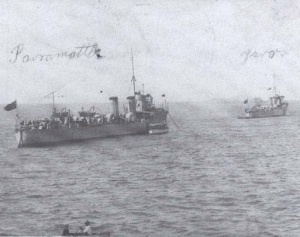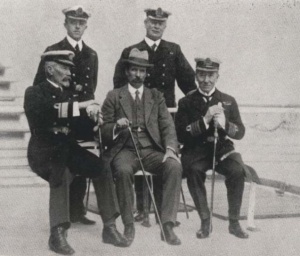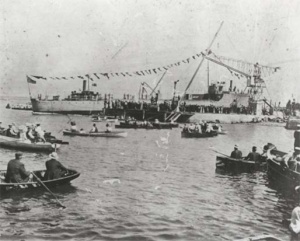2011 - A Year of Naval Commemoration
It is further humbly submitted to Your Majesty that the Naval Forces of the Dominions of Canada and Australia, should, in accordance with their wishes, have the prefix ‘ROYAL’ attached to the official title of those Forces, the Ships of War of the Dominions being called His Majesty’s Canadian and Australian ships respectively.
Reginald McKenna, First Lord of the Admiralty,
10 July 1911
I approve of this memorandum with great satisfaction.
G.R.I.[1]
In 2011 the Royal Australian Navy (RAN) embarked on an ongoing project to commemorate the centenaries of some very significant historical events. These events, ranging from the granting of the ‘Royal’ prefix to the Australian Navy in July 1911 through to the bitter struggle to achieve Allied victory in the Great War from 1914 to 1918, were highlighted to a naval and wider audience under the banner of “Serving Australia Since Federation”.[2]
The events chosen for commemoration are important not only to the RAN, but also to the broader Australian population. We are without doubt a maritime state, and our growth and national development cannot be understood without constant reference to the sea. For its part, the Navy is one of Australia’s oldest national institutions, and its close involvement in nation-building and the trials of the First World War were fundamental to Australia’s entry onto the world stage as an independent actor. Indeed, without recognition of where we have come from, it is impossible to appreciate the how and why of Australian actions today.
Reaching a century is a milestone for any individual or institution, and the RAN is no exception. Although Australia’s Navy came into being on 1 March 1901,[3] a few months after Federation, it was known at first as the Commonwealth Naval Forces (CNF). Adequate for the minimal coastal defence forces then existing, this title did little to reflect Australia’s growing desire to assume full responsibility for its own broader maritime defence.
At the time, Australia’s most important security relationship was with the United Kingdom. Under the provisions of the Naval Agreement Acts 1902-03, Australia and New Zealand both accepted that they would contribute to maintaining a Royal Navy squadron in the region until at least 1913. The agreement was a continuation of the general pledge that the Royal Navy would maintain the Commonwealth’s territorial integrity, but it remained unpopular in Australia. The annual grant of £200,000 to Britain - far less than half the estimated running costs - was generally felt to do nothing for Australia’s national interests. In fact, with the squadron likely to be removed in time of war, and offering few if any training opportunities to interested locals, the situation was frequently described as being akin to taxation with representation.
Gradually the activities of maritime-minded individuals, such as the Director of Naval Forces, Captain (later Vice Admiral Sir) William R Creswell, encouraged political interest in an effective blue-water navy. Finally, on 5 February 1909 a new labor administration, under Prime Minister Andrew Fisher, announced its decision to order three destroyers from British shipyards. The first two (HMA Ships Yarra and Parramatta), were to be completed and sailed under their own power from Great Britain, and the third vessel (HMAS Warrego) was to be erected overseas, then disassembled and re-built in Australia.
Plans for an independent Australian destroyer flotilla were soon overshadowed by a far more audacious proposal, however. At the Imperial Conference held in London in July 1909, the Australian delegation was informed that in the face of foreign naval expansion the Royal Navy could no longer guarantee sea supremacy. By 1915, the position of Australia, isolated and remote from British naval strength, “might be one of some danger”. The solution proposed required Australia to acquire a self contained ‘fleet unit’, comprising one battle cruiser and three light cruisers. Together with a flotilla of destroyers and submarines the result would be a credible oceangoing fleet. The Australian Cabinet gave provisional endorsement on 27 September and work on the force proceeded rapidly.
A new Naval Defence Act, passed on 25 November 1910, provided the clear legislative authority needed for the enhanced maritime force. This was to be a true national navy, a force capable not only of defending Australia’s maritime interests, but also allowing Australia to make a practical contribution to the regional defence of the British Empire. To reflect this added responsibility, and in particular the Australian Navy’s planned integration with the imperial fleet, the Australian representatives at the 1911 Imperial Conference requested that the King approve the addition of the ‘Royal‘ prefix. King George V’s subsequent approval was promulgated by a Commonwealth Naval Order on 5 October the same year.
The Australian ‘Fleet Unit’ eventually sailed into Sydney Harbour on 4 October 1913, but over the preceding few years much had been accomplished to reduce risks and ensure that the RAN would be a success. Some of the key steps taken in 1911 included:
March-December - The newly arrived Yarra and Parramatta sail on a flag showing cruise along the east coast of Australia. Ports visited include Cairns, Townsville, Bowen, Rockhampton, Gladstone, Brisbane, Byron Bay, Coffs Harbour, Newcastle, Sydney, Williamstown, Devonport and Burnie.
1 March - Admiral Sir Reginald Henderson submitted his ‘Recommendations’ to the Commonwealth Government. The report advocated a progressive expansion of the RAN extending over a generation. By 1933, Henderson estimated the Navy should comprise eight battlecruisers, ten light cruisers, eighteen destroyers, twelve submarines and 15,000 personnel. Sixteen bases and sub-bases around Australia would support the fleet.
11 March - The Australian Commonwealth Naval Board reconstituted. It consisted of the President (The Minister for Defence); the First Naval Member, responsible for war preparations, intelligence, ordnance, fleet operations and naval works; the Second Naval Member, responsible for personnel and stores; the Third Naval Member, responsible for the construction and repair of ships; and the Finance and Civil Member who dealt with finance and contracts.
April-August - The gunboat HMAS Gayundah, carries out a ‘Special Cruise’ to enforce Australia’s maritime sovereignty off the remote north-west coast. Two Dutch schooners arrested for fishing illegally in territorial waters.
4 April - Warrego, launched at Cockatoo Island. The first destroyer assembled in Australia, its reconstruction provided vital experience for Australian ship-builders, who went on to build three more destroyers of the same class.
11 April - Central administration transferred to the Australian Navy Office in Lonsdale Street, Melbourne.
May - The Naval Militia Forces become the Commonwealth Naval Reserve.
June - An Imperial Conference in London defines the relationship between the Australian Navy and the British Fleet. This includes the direction that Dominion ships will hoist at the stern the the White Ensign as the symbol of the authority of the Crown, and at the jack staff the distinctive flag of the Commonwealth.
15 September - The House of Representatives informed that the Australia Station has been defined as the waters between 95° E and 160° E as far south as the Antarctic Circle. The northern boundary is drawn to exclude the Cocos Group, all Dutch East Indies islands and German New Guinea, while including the coast of British New Guinea. The eastern boundary is extended to include Noumea and the New Hebrides (Vanuatu).
23 October - The RAN’s first flagship, the battlecruiser HMAS Australia, is launched at Clydebank, Scotland.
16 November - The Australian Government announces its decision to build the Royal Australian Naval College at Jervis Bay, NSW.
During 2011 several editions of Hindsight were devoted to exploring these events in more detail.
References
- ↑ Memorandum submitted to His Majesty King George V by Reginald McKenna, First Lord of the Admiralty, 10 July 1911. Copy on SPC-A file, ‘Designation of Naval Forces of the Commonwealth’, 184c.
- ↑ See, Serving Australia since Federation (1.5 MB PDF)
- ↑ The Navy continues to recognise 1 March 1901 as its birthday, meaning that in 2011 the Australian Navy celebrates the 110th anniversary of its foundation.





